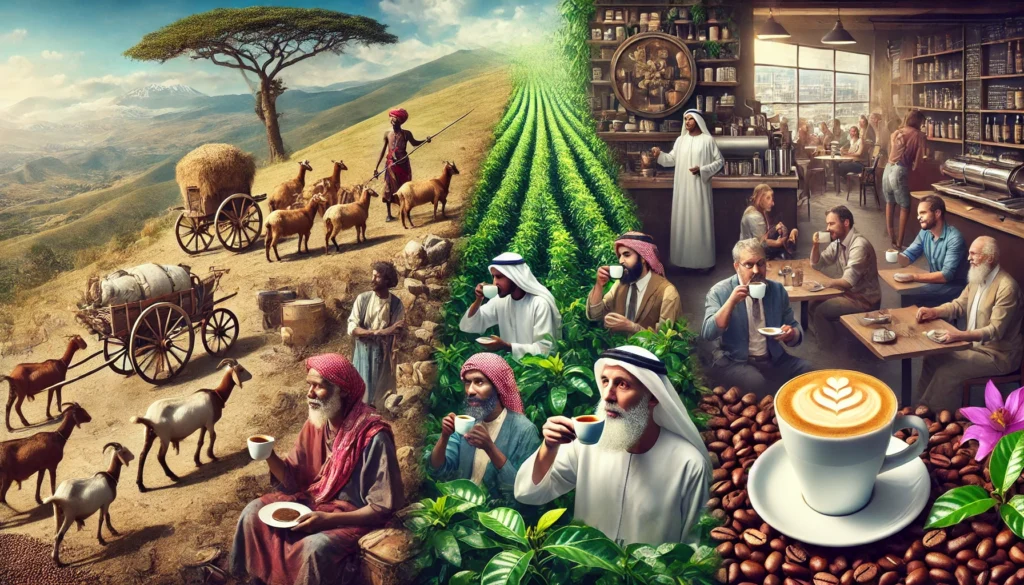Few beverages have influenced global culture, trade, and daily life as deeply as coffee. From humble beginnings in the Ethiopian highlands to becoming the morning ritual of millions, the journey of coffee is rich, complex, and full of fascinating twists.
In this article, you’ll discover the history of coffee, how it spread across continents, and surprising facts about the world’s favorite drink.
The Legend of Kaldi: Coffee’s Mythical Origin
According to popular legend, coffee was first discovered in Ethiopia around the 9th century. A goat herder named Kaldi noticed that his goats became unusually energetic after eating red berries from a mysterious shrub. Curious, Kaldi tried the berries himself and felt a burst of vitality.
He shared his discovery with local monks, who initially rejected the berries and threw them into the fire. But as the beans roasted, they released a captivating aroma. The monks retrieved them, brewed a drink, and soon the first cup of coffee was born.
Though this story is more myth than fact, it sets the stage for coffee’s journey from Ethiopia to the rest of the world.
Coffee’s Spread Through the Arab World
Coffee cultivation began on the Arabian Peninsula, particularly in Yemen during the 15th century. Sufi monks used coffee to stay awake during long nights of prayer and meditation.
From Yemen, coffee spread quickly to Egypt, Persia, and Turkey. By the 16th century, it was deeply embedded in Middle Eastern culture. Public coffeehouses, called qahveh khaneh, appeared in cities like Mecca, Cairo, and Constantinople. These spaces became hubs for conversation, music, games, and even political debate—much like cafés today.
Because alcohol was forbidden, coffee became a socially acceptable alternative. Its stimulating effects earned it the nickname “wine of Islam.” The beverage was more than a drink; it was a cultural phenomenon.
The European Encounter with Coffee
When coffee arrived in Europe in the 17th century via Venetian traders, it was met with suspicion. Some critics even called it the “bitter invention of Satan.” But after Pope Clement VIII tasted and approved it, coffeehouses began to flourish across the continent.
In London, Paris, and Vienna, coffeehouses quickly became centers of intellectual life. In England, they were nicknamed “penny universities” because, for the price of a penny, one could buy a cup of coffee and engage in stimulating discussions about science, politics, and art.
These venues played a major role in the Enlightenment, fueling ideas that shaped modern society.
Coffee, Colonialism, and Global Trade
As demand grew in Europe, colonial powers began cultivating coffee in their overseas territories. The Dutch introduced it to Java, the French to the Caribbean, and the Portuguese to Brazil.
Unfortunately, the rise of coffee as a global commodity was tied to the exploitation of enslaved labor. Plantations across the tropics thrived at the expense of human suffering, leaving a painful legacy that cannot be ignored.
By the 19th century, Brazil had become the world’s largest coffee producer—a title it still holds today. Coffee transformed Brazil’s economy, fueled urban growth, and shaped its cultural identity. Regions like São Paulo and Minas Gerais became synonymous with high-quality Arabica beans, solidifying Brazil’s reputation as a coffee powerhouse. Even today, Brazil continues to lead innovation and sustainability in the coffee industry.
The Evolution of Coffee Culture
In Italy, the invention of espresso revolutionized how coffee was consumed. Quick, strong, and social, espresso became a national staple.
In Sweden and Finland, coffee breaks known as fika are a cherished daily ritual, often accompanied by pastries and conversation.
In the United States, coffee evolved from diner refills to the rise of specialty chains like Starbucks, which redefined coffee culture as customizable and on-the-go.
More recently, the third wave of coffee movement has emerged. Like wine, coffee is now valued for its terroir, origin, and craftsmanship. From single-origin beans to innovative brewing methods, coffee culture is more diverse and refined than ever.
Fun Facts About Coffee
To make this journey even more exciting, here are some surprising coffee facts:
- Beethoven was obsessed with precision—he counted exactly 60 coffee beans per cup.
- Coffee was once banned in Mecca in the 16th century for being too stimulating.
- The word coffee comes from the Arabic qahwa, which originally meant “wine.”
- Finland leads the world in coffee consumption—each person drinks over 10 kg per year.
- Decaf coffee was invented by accident when a shipment of beans was soaked in seawater.
Health Benefits, Myths, and Truths
Modern studies show that moderate coffee consumption can lower the risk of diseases such as Parkinson’s, Alzheimer’s, and type 2 diabetes. Coffee is also linked to improved focus, energy, and athletic performance.
Some myths persist:
- Myth: Coffee stunts growth.
Truth: No scientific evidence supports this claim. - Myth: Coffee is bad for the heart.
Truth: Moderate consumption may actually protect cardiovascular health.
Beyond drinking, coffee is used in cosmetics and wellness products thanks to its antioxidant and anti-inflammatory properties.
The Future of Coffee
Climate change poses a serious threat to coffee-growing regions. Rising temperatures and changing rainfall patterns could impact both yield and flavor.
To address these challenges, producers are focusing on sustainability and fair-trade practices, ensuring environmental protection and better wages for farmers.
From cold brew to innovative capsule systems, coffee continues to reinvent itself. The future promises even more variety and personalization for coffee lovers worldwide.
Why the History of Coffee Still Matters
The story of coffee is not just about a beverage—it’s about people, culture, and connection. From Ethiopian legends to your morning espresso, coffee has shaped economies, inspired revolutions, and brought communities together.
The next time you sip your favorite brew, remember: inside that cup is a history of resilience, creativity, and global connection.
Coffee isn’t just a drink—it’s a story still being written, one cup at a time.
